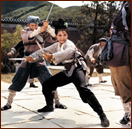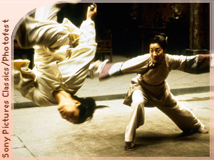
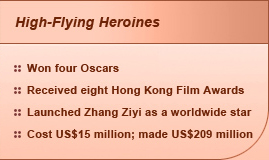
The martial arts film is very masculine, but our film finds its center in its women characters. It is the women who in the end are walking
‘the way [of Tao].’
—director Ang Lee
Before Ang Lee’s elegant film Crouching Tiger, Hidden Dragon, Chinese-language martial arts films about women were not likely candidates for global box-office hits. Yet the Mandarin-language film about a young woman’s journey of self-discovery became an international success, winning an unprecedented number of awards and breaking box-office records around the world (except in China, Korea and Hong Kong, because audiences were used to this type of genre epic). Based on a novel by Du Lu Wang, this Taiwanese-produced film popularized a genre that featured prominent action roles for women and proved that Western audiences were ready for high-flying heroines. The success of Crouching Tiger further opened cinematic borders in the West for Asian imports, and a slew of martial arts films starring women followed in its wake, including Yimou Zhang’s Hero (2002) and House of Flying Daggers (2004).
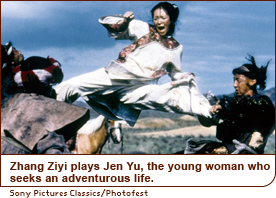 The complex plot of Crouching Tiger centers around three characters: honorable warrior Li Mu Bai (Chow Yun-Fat), who wishes to leave behind his killing days; warrior Yu Shu Lien (Michelle Yeoh), once betrothed to Li’s now-dead best friend and caught up in mutual albeit unspoken yearning with Li; young Jen Yu (Zhang Ziyi), a governor’s daughter approaching an arranged marriage while longing for freedom. Jen idolizes Yu, a powerful woman who lives an adventurous and independent life. Li seeks to avenge the murder of his master at the hands of Jade Fox (Cheng Pei-Pei), an older woman aided by a mysterious disciple—who turns out to be Jen, the pupil whose skills have surpassed those of her evil mentor.
The complex plot of Crouching Tiger centers around three characters: honorable warrior Li Mu Bai (Chow Yun-Fat), who wishes to leave behind his killing days; warrior Yu Shu Lien (Michelle Yeoh), once betrothed to Li’s now-dead best friend and caught up in mutual albeit unspoken yearning with Li; young Jen Yu (Zhang Ziyi), a governor’s daughter approaching an arranged marriage while longing for freedom. Jen idolizes Yu, a powerful woman who lives an adventurous and independent life. Li seeks to avenge the murder of his master at the hands of Jade Fox (Cheng Pei-Pei), an older woman aided by a mysterious disciple—who turns out to be Jen, the pupil whose skills have surpassed those of her evil mentor.
Coming of Age, Wuxia-Style
While there are many movies featuring women of action, relatively few from the West center on a heroine who wants to define herself through action rather than through romance or family. For example, in the Kill Bill (2003, 2004) films, Uma Thurman’s epic warrior sees herself first as the lover/disciple of her employer, and then assumes the role of mother—her awesome fighting abilities are merely a means to an end. In Crouching Tiger, however, Jen’s desire to exist apart from her relationships as daughter/lover/wife is primarily expressed through martial arts prowess. As Boston Globe reviewer Jay Carr notes, “The women can do anything the men can do and there are more of them.”
Martial arts master Yuen Wu-Ping created entrancing action choreography for both genders, utilizing blades, hands, feet and some surreal feats. While flying is not uncommon in the wuxia genre, the flying style is more graceful than that of traditional Hong Kong kung fu films. The wire work served to further cement the popularity of gravity-defying, floating combat in the West, which had already begun to catch on with 1999’s The Matrix, also choreographed by Wu-Ping. The earthbound fight sequences in Crouching Tiger are also impressive: The film won an MTV 2001 Movie Award for Best Fight: Zhang Ziyi vs. the Entire Bar.
Women and the Way
It is not unusual for women and men to fight as equals in wuxia films, but Lee departs from the genre in that Crouching Tiger’s primary conflict is not simply between protagonists. Indeed, the film takes a loftier look at how women (both heroines and villains) negotiate societal obligations. Female characters must choose whether to accept or reject their prescribed roles as women, the results of which are both tragic and heroic. 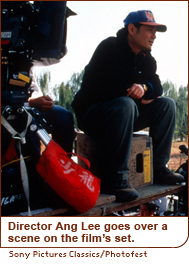 The film is equal parts adventure and epic romance, and emotional drama is at its core. In an interview on Crouching Tiger’s official website, veteran action actress Yeoh commented that in martial arts movies she’d performed in previously, “We have always put loyalty, honor, tradition and martial arts ahead of everything else, but [director/producer Ang Lee] deals with inner emotions like fear and death, which is something that we’ve touched on but we have never truly explored [before] in that way.”
The film is equal parts adventure and epic romance, and emotional drama is at its core. In an interview on Crouching Tiger’s official website, veteran action actress Yeoh commented that in martial arts movies she’d performed in previously, “We have always put loyalty, honor, tradition and martial arts ahead of everything else, but [director/producer Ang Lee] deals with inner emotions like fear and death, which is something that we’ve touched on but we have never truly explored [before] in that way.”
Indeed, Lee hoped to create a film that would fuse action and emotion, as he explained: “The film is an attempt to blend mass entertainment with the Tao, ‘the way.’ What is the Tao, ‘the way?’ Of course, if you can say it, it’s not the real Tao. It’s enigmatic in that it can only manifest itself through contradictions, through the conflicts of the heart, rather than through the harmony it seeks.” Crouching Tiger, Hidden Dragon is the first film to achieve hit status in the West that revolves around the precept that martial arts prowess may be at the heart of a woman’s way.
Crouching Tiger was also a landmark film because it was scripted in the mythical story structure of “the hero's journey,” but the “hero” is a young woman. In his influential work, The Hero with a Thousand Faces (1949), Joseph Campbell identified a recurring “hero's journey” archetype in mythology across all the world’s cultures, in which a hero is challenged by a series of obstacles and temptations, assisted by various mentors, and finally overcomes his internal and external enemies. 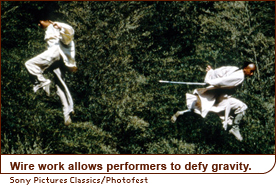 Many films exemplify this “hero's journey” archetype, with Star Wars (1977) and The Matrix (1999) notable among them. But until Crouching Tiger, no successful film featuring a female hero had followed this enduring archetype, and indeed, before Crouching Tiger, it could be argued that only men could successfully fill the shoes of Campbell’s classical “hero.” In Crouching Tiger, however, Ziyi’s character faced conflict, challenges, love and temptation; trained under good and evil mentors; and ultimately triumphed over both her internal and external enemies. And in doing so, she established that a female hero could credibly tap mythological archetypes to powerfully resonate with a modern audience, paving the way for many more stories of women heroes—or more precisely, heroines—in the future.
Many films exemplify this “hero's journey” archetype, with Star Wars (1977) and The Matrix (1999) notable among them. But until Crouching Tiger, no successful film featuring a female hero had followed this enduring archetype, and indeed, before Crouching Tiger, it could be argued that only men could successfully fill the shoes of Campbell’s classical “hero.” In Crouching Tiger, however, Ziyi’s character faced conflict, challenges, love and temptation; trained under good and evil mentors; and ultimately triumphed over both her internal and external enemies. And in doing so, she established that a female hero could credibly tap mythological archetypes to powerfully resonate with a modern audience, paving the way for many more stories of women heroes—or more precisely, heroines—in the future.
:: woa.tv staff





